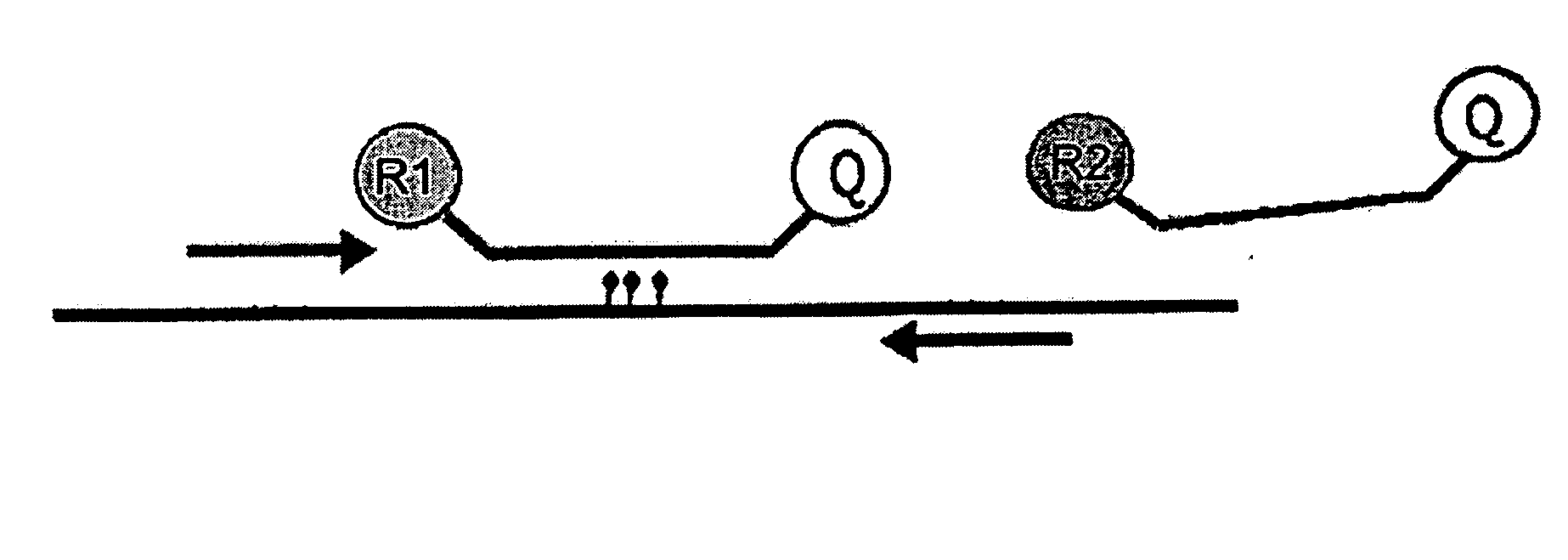Method for the quantification of methylated DNA
a methylation and methylation technology, applied in the field of methylation, can solve the problems of non-uniform amplification, difficult detection of 5-methylcytosine using particular standard methods, and inapplicability of conventional dna analysis methods based on hybridization, for example, and achieve the effect of reducing the number of methylation and methylation
- Summary
- Abstract
- Description
- Claims
- Application Information
AI Technical Summary
Benefits of technology
Problems solved by technology
Method used
Image
Examples
example 1
The Degree of Methylation of the Two Genes S100A2 and TFF1 was Analyzed
[0073] Particular aspects of the present invention provide for a reliable quantification of DNA methylation. For this purpose, the degree of methylation of the two genes S100A2 and TFF1 will be analyzed.
[0074] Calibration curves with several DNA mixtures of different degrees of methylation were plotted. A series of DNA mixtures of known degrees of methylation were used as the standard (0, 5, 10, 25, 50, 75 and 100% methylated DNA). For the production of this “gold standard,” completely methylated and completely unmethylated DNA were mixed together in different ratios. The completely unmethylated DNA was obtained from Molecular Staging, where it was prepared by means of a multiple displacement amplification of human genomic DNA from whole blood. The completely methylated DNA was produced by means of an Sss1 treatment of the completely unmethylated DNA according to the manufacturer's instructions. The DNA was the...
example 2
Inventive Methods Were Used to Provide a Reliable Quantification of the Methylation of Different Types of Samples
[0080] Additional aspects of the present invention provide for a reliable quantification of the methylation of different types of samples. For this purpose, a portion of the biological sample material was fresh frozen, and the remainder was embedded in paraffin. Using standard, art-recognized techniques, the DNA was then isolated from the sample, and was treated with a bisulfite reagent (see, e.g. PCT / EP2004 / 011715, incorporated by reference herein in its entirety). The treated DNA was amplified by means of two non-methylation-specific primers in the presence of two Taqman oligonucleotide probes. One of the oligonucleotide probes was specific for the methylated state, and the other for the unmethylated state of the investigated gene. Both probes had a reporter fluorescent dye at the 5′-end and a quencher at the 3′-end. The reactions were calibrated with DNA standards of ...
example 3
Reliability of the QM Assay Was Demonstrated Over a Broad Range of Input DNA
[0084] Experiments were preformed to demonstrate that the inventive QM assays perform well over a wide range of input DNA amounts. Different amounts of bisulfite-treated DNA (50, 10, 5, and 1 ng) derived from nine different samples (e.g., fresh frozen tissue samples, and paraffin embedded tissue samples) were analyzed by the inventive QM assay.
[0085] The results are illustrated in FIG. 6, which shows that the QM assays perform well over a wide range of input DNA. The determined methylation degree is independent of the DNA input amount. The standard deviation does not exceed a value of ±5 percentage points around the mean of measured methylation rate. This value of the standard deviation is caused by the interplate variablity (see Example 4 below).
PUM
| Property | Measurement | Unit |
|---|---|---|
| Tm | aaaaa | aaaaa |
| volume | aaaaa | aaaaa |
| temperature | aaaaa | aaaaa |
Abstract
Description
Claims
Application Information
 Login to View More
Login to View More - R&D
- Intellectual Property
- Life Sciences
- Materials
- Tech Scout
- Unparalleled Data Quality
- Higher Quality Content
- 60% Fewer Hallucinations
Browse by: Latest US Patents, China's latest patents, Technical Efficacy Thesaurus, Application Domain, Technology Topic, Popular Technical Reports.
© 2025 PatSnap. All rights reserved.Legal|Privacy policy|Modern Slavery Act Transparency Statement|Sitemap|About US| Contact US: help@patsnap.com



